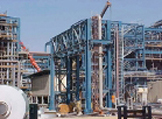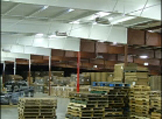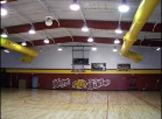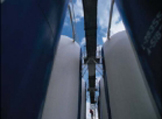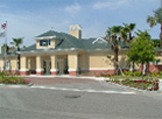Painting Terms

Learn Painting Terms - F
Browse Our Painting Terms
Fabric Roller - An application tool made from a high nap fabric and designed to apply paint by saturating with paint and rolling across the surface.
Factory - An industrial production plant, especially one in which manufacturing takes place. Extractive facilities, such as mines and refineries, are usually excluded from this description.
Fadding - Applying shellac with a pad called a fad.
Fading - Lightening of the paint's color, usually caused by exposure to light or heat.
Fanning - Moving the arm back and forth, like a oscillating fan, while spray painting.
Fascia - The flat, vertical member or band on the outside edge of a cornice or eaves. A decorative trim or panel projecting from the face of a wall.
Fast To Light - Colors which are not affected by light.
Fat Edge - A ridge of paint which forms at the bottom edge of a painted surface when too much free-flowing paint has been applied.
Fattening - An increase in the thickness or viscosity of paint after storage which can make it unsuitable for use without an additive.
Faux Finish - A specialty finish like color washing, marbleizing, sponge painting, etc. Expect to pay a lot more for this type of finish. Make sure you see samples of rooms the contractor actually completed before signing a contract. Done right, these can take your breath away; done wrong and you'll hire someone to paint over it before another day dawns.
Feather - A technique of brushing paint to smooth edges and blend with previously painted surfaces.
Feather Sanding - Tapering the edge of dried paint film with sandpaper.
Feathering - A process used to blend a small area into its surroundings after spot-priming, applying a filler, or scraping off an area of old paint.
Feeding - The process that changes a paint or varnish, while in the container, into a rubbery jelly so it cannot be used. Also called livering.
Feel - The working qualities of paint. The paint can be mixed and thinned until it has the right "feel" for each individual painter.
Felting Down - Deglossing a dry varnish or painted surface with a felt pad loaded with abrasive powder and lubricated with water.
Ferrous Metal - A metal containing or derived from iron and subject to rust.
Ferrous Sulfate - A green, crystalline salt compound used in the making of inks, dyes and paint.
Ferrule - The metal band that connects the handle and stock of a paint brush.
Field Painting - The surface preparation and application of one or more coats of paint to structural steel, concrete, or other materials conducted at the construction or project site rather than in the fabricating shop.
Filaments - The part of a synthetic paint brush that holds and applies the paint. In a natural bristle brush, the filaments are often referred to as bristles.
Filler - (1) A finely-divided inert compound which is added to portland cement paint to reduce shrinkage, improve workability or act as an extender. (2) A compound used for stopping up holes, cracks, checks, pores and blemishes in wood before applying a finish such as stain, varnish or paint.
Filler Coat - The first coat of paint applied to fill the cracks, pores and holes in wood to make a smooth surface for the finish coat. Also called prime, coat or priming.
Filler Strips - Strips made from specially treated wood, metal. Fiber or plastic in the center of a paintbrush, creating a reservoir of paint, thereby greatly increasing the paint carrying capacity.
Film - A layer or coat of paint or other material applied to the surface. The layer remaining after the paint has dried is often called the dried film.
Film Build - The group of flow properties of a liquid coating that determine the wet film thickness that can be applied in a single coat without producing runs, sags, or other film defects; or, the group of per-coat dry film thickness characteristics of a paint.
Film Formation - The paint's ability to form a continuous dry film. This process is the result of the water or solvents evaporating and the coming together of the binder particles. A continuous dry film repels water.
Film Former - A substance, namely a paint or other liquid material which can be applied to a surface and which forms a continuous dry coating after drying (curing), or the portion of the paint or other liquid material that remains as a coating after drying.
Film Integrity - The measure of continuity of a coating film. Coatings with no or very few defects have a high degree of film integrity.
Film Thickness - Thickness of a film material, including the thickness of any applied coating film, wet or dry, on a substrate. This type of film thickness is measured in mils, which are thousandths of an inch.
Film Thickness Gage - An instrument used for measuring the wet or dry film thickness of a coating.
Filter - A screen or cloth used to remove solid material from a liquid. Paint is filtered before spray painting.
Fingering - The improper application of paint that causes lines (fingers) in the finished surface. In spraying, when more paint is applied to one part of the pattern than another. In brushing, when bristles stick together. Also called tails.
Finish Coat - Final coat of paint. Sometimes referred to as a topcoat.
Finish System - A particular combination of primers, topcoats, and pretreatment materials that are used on a specific type of surface in order to obtain a desired result (i.e. camouflage, chemical agent resistance, etc.) Also referred to as a paint system.
Fire Resistance - The ability of a coating to withstand fire or to protect the substrate to which it is applied from fire damage.
Fire Resistance Rating - The measured time in hours that an assembly will withstand fire or give protection from it.
Fire Retardant - A coating which will reduce flame spread, resist ignition when exposed to high temperature or insulate the substrate and delay damage to the substrate.
Fire Retardant Chemical - A chemical compound used to reduce the spread of flame or to reduce flammability.
Fire Retardant Rating - A standard test rating of fire-resistive or protective qualities in building materials or assemblies.
Fire Resistant Coating Material - A thermal barrier coating material made to resist combustion.
Fire Resisting Finishes - Paints which contain silicones, polyvinyl chloride, chlorinated waxes, urea formaldehyde resins, casein, borax or other noncombustible substances which reduce the spread of fire on combustible materials.
Fire Retardant Paint - A paint that is a fire-resistant material and is applied to reduce the rate of flame spread of combustible materials. Fire-retardant paint is often based on silicone, casein, or polyvinyl chloride.
Fish Eye - (1) A skip in the finished surface. Also called cat eyes, cat face or holidays. (2) The paint separates away from a contaminated area (i.e. grease, silicone, etc.) caused by improper surface preparation.
Fish Oil - A component of many primer paints which prevents or inhibits rust.
Flagging - Synthetic filaments have the ends mechanically split to create a featured appearance which provide superior paint performance. (See tipping)
Flaking - A form of paint failure characterized by the detachment of small pieces of the film from the surface of previous coat of paint. Cracking or blistering usually precedes it.
Flame Cleaning - The process of cleaning a structural steel surface by passing an intensely hot acetylene-oxygen flame over it. Mill scale and rust are removed by the reducing effect of the flame and the action of the heat, leaving the surface in a condition suitable for wire brushing and painting.
Flammability - The ability of a substance to ignite, having a flash point under 1000 F (37.50C).
Flash - Uneven gloss or color resulting from an unsealed substrate or excessively high or low temperatures during drying.
Flash Point - The temperature at which a coating or solvent produces vapors that are capable of being ignited when exposed to a spark or flame.
Flashing - Uneven gloss with shiny or dull spots on painted surfaces. Usually caused by - improper or lack of priming of porous surfaces; poor painting techniques; painting over fresh paint or primer before it's dry; uneven film thickness; drying during excessive high/low temperatures.
Flat - A surface that scatters or absorbs the light falling on it so as to be substantially free from gloss or sheen (0-15 gloss on a 60-degree gloss meter). Flat paint is less durable than higher gloss paint.
Flat Applicator - A rectangular shaped flat pad with an attached handle that is used to paint shingles, shakes and other special surfaces and areas.
Flat Coat - The first coat of paint applied, usually a primer coat.
Flat Spots - Spots on a finished surface which lack gloss or luster.
Flat Wall Paint - A term used to describe the flat finish paint which is usually applied to walls.
Flatting - A finish applied to painted surfaces which leaves no gloss or luster.
Flatting Agent - A paint or varnish additive which reduces the gloss of a finished surface.
Flatting Down - Using an abrasive such as cuttlefish, powdered pumice and felt or glass paper to sand a painted surface.
Flatting Varnish - A varnish undercoat which contains hard resin.
Flexibility - Ability of a coating to expand and contract during temperature changes.
Floating - Separation of pigment colors on the surface of applied paint.
Flocking - Forming a textile-appearing surface by blowing textile material such as silk or cotton on a freshly painted tacky surface.
Floor Plan - An architectural drawing of the top view of a building showing the location of each of the rooms.
Floor Varnish - Varnish which contains a nonslip, non-skid abrasive.
Flow - The ability of a coating to level out and spread into a smooth film, paints that have a good flow usually level out uniformly and exhibit few brush or roller marks.
Flow Leveling Failure - Excessive brush or roller marks causing non-uniform surface. Usually caused by - using wrong type of roller or brush; poor painting techniques; repainting partially dried areas; or painting non-primed surfaces.
Flying Scaffolding - Scaffolding hung from an outrigger beam.
Foam Roller - A tool that is similar to a fabric roller but made from synthetic foam rubber. It is designed for clear, fine finishes.
Foaming Cratering - Excessive bubbling that leaves craters or depressions in the paint film. Usually caused by using wrong roller; rolling paint too fast; using old paint; painting over unprimed porous surfaces; or painting when the temperature is over 90F.
Foggy - When a paint that should have a shine has dulled off to a flat finish.
Foots - Paint solids which settle to the bottom of the paint container.
Forced Drying - Drying paint at temperatures below 150 degrees F.
Framing Plan - An architectural plan which locates and identifies all the wood framing members necessary to build a structure.
French Door - An architectural term used to describe a door with glazed panels extending its full height and width.
Fresco - Painting wet plastered walls or ceilings.
Frieze - A horizontal band of decoration around a room, building, mantle, etc.
Frosting - A translucent, finely-wrinkled finish formed during drying.
Full Gloss - The highest grade of gloss paint.
Fungicide - An ingredient used in some coatings and sealants to help keep mildew and other fungi from growing on the surface.
Call Now - 1.800.354.9165 - Toll Free

